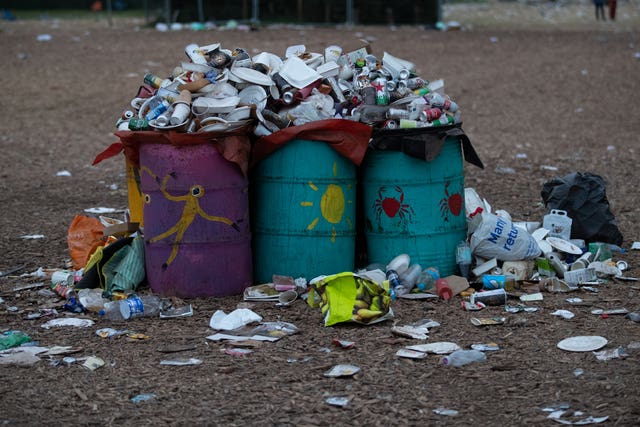Army of workers and volunteers begins Glastonbury Festival clean-up
Hundreds of litter-pickers began their final clear-up of the musical extravaganza in the early hours of Monday.

An extensive clear-up operation has begun at Glastonbury Festival – returning the site from a pop-up city of 200,000 people to a Somerset dairy farm.
More than 1,300 volunteers have begun shifting rubbish strewn across the 900-acre site as festival-goers make their way home after headline performances by Stormzy, The Killers and The Cure.
They began picking up discarded items including plastic bottles, cans, food containers and cool boxes left around the site.
The crew tackled bins over-flowing with waste and discarded items including camping chairs, blow-up mattresses, slippers, flip-flops and shopping bags.
On Sunday, Sir David Attenborough made a surprise appearance on the Pyramid Stage, where he praised festival organisers for banning single-use plastics.
“There was one sequence in Blue Planet II which everyone seems to remember,” Sir David said to the crowd.
“It is one in which we showed what plastic has done to the creatures that live in the ocean.
“It had an extraordinary effect and now this great festival has gone plastic-free.”

No single-use plastic bottles were sold at the festival, or available in the backstage areas, though many of those attending the event brought them to the site.
The mammoth task of returning Worthy Farm to a herd of 1,000 cows cost £785,000 in 2017 and could take up to six weeks to complete.
In 2017, more than 60 tonnes of paper and card, 32 tonnes of glasses, 45 tonnes of cans, and 40 tonnes of plastic bottles were recycled.
That year, 132 tonnes of food waste was turned into compost, while 4,500 litres of cooking oil was made into biofuel.
In an interview with the Glastonbury Free Press, Emily Eavis said she thought festival-goers would return home with their belongings after the five-day event.
“I think people are really starting to understand how important it is to treat the land with respect and to stop living a disposable lifestyle,” she said.
There appeared to be few abandoned tents compared to previous years.
In 2016, the festival launched the “Love the Farm, Leave no Trace” pledge and a year later saw an 81% reduction in tents left there.
Climate change and the environment has been a central theme for this year’s event.
The confetti showered over the crowd in sets including by Years And Years and Kylie was biodegradable.

Organisers hope that those attending Glastonbury Festival will return home and be inspired to live more sustainably.
Around 40% of those attending Glastonbury come by public transport.
While Glastonbury has a reputation for mud and rain, this year saw hot and dry conditions with temperatures reaching more than 28C (82F).
There were 850 water points across the 900-acre site for people to refill their reusable bottles, with 37 WaterAid kiosks.
The Somerset festival was closed by The Cure, who were headlining for the fourth time.
Preparations for the 2020 event, the 50th anniversary of the festival, are already under way.
Emily Eavis has already promised that it will be a “huge celebration”.
A book to mark the occasion, named Glastonbury 50, will be released in October this year.





